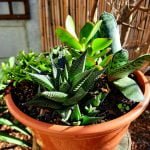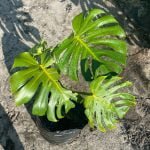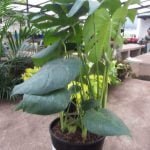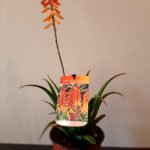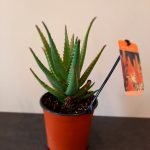Showing 1921–1932 of 2066 resultsSorted by popularity
- Sale!

Philodendron “Painted Lady” 20cm Pot
Original price was: R295.00.R169.99Current price is: R169.99.Add to cartPhilodendron “Painted Lady” 20cm Pot
Philodendron “Painted Lady” is a cultivar of Philodendron, prized for its striking foliage.
Light
Provide bright, indirect light for your Philodendron “Painted Lady”. While it can tolerate lower light conditions, it may not develop its characteristic colouring without sufficient light. Avoid direct sunlight, as it can scorch the leaves.Watering
Allow the top inch or two of the soil to dry out between watering. Water thoroughly, but ensure that excess water can drain away freely to prevent waterlogging, which can lead to root rot.Temperature
Maintain temperatures between 65°F to 80°F (18°C to 27°C) for your Philodendron “Painted Lady”. Avoid exposing it to cold drafts or sudden temperature changes.Humidity
Philodendrons generally appreciate moderate to high humidity levels. If the air in your home is dry, you can increase humidity by misting the leaves, using a humidifier, or placing the plant on a tray filled with water and pebbles.Soil
Plant your Philodendron “Painted Lady” in well-draining potting soil. A mix formulated for tropical plants or a blend of peat moss, perlite, and coarse sand works well.Fertilisation
Feed your Philodendron “Painted Lady” with a balanced liquid fertiliser diluted to half strength every 4-6 weeks during the growing season (spring and summer). Reduce or stop fertilising in the fall and winter when growth slows down.Pruning
Regularly remove any yellowing or damaged leaves to promote healthy growth. You can also prune to shape the plant or control its size if it becomes too large.Leaf Colouration
The leaves of Philodendron “Painted Lady” typically display a combination of bright shades such as yellow, gold, lime green, and chartreuse. These colours often form patterns or variegation across the surface of the leaves.Variegation
The variegation on the leaves can vary from plant to plant, but it generally consists of patches, streaks, or marbling of lighter and darker colours. The variegation adds visual interest and depth to the foliage.Leaf Shape and Texture
Like many Philodendron varieties, the leaves of “Painted Lady” are typically heart-shaped or ovate. They have a smooth texture and may develop splits or lobes as the plant matures.Growth Habit
Philodendron “Painted Lady” tends to grow in an upright manner, with stems emerging from a central point. It can develop a bushy appearance over time as new leaves emerge from the middle of the plant.Size
The size of the leaves and overall plant can vary depending on environmental conditions and care. Generally, “Painted Lady” remains relatively compact compared to some other Philodendron varieties, making it suitable for smaller indoor spaces. 
Succulent Mix Bowl 21cm
All Indoor Plants, All Plants, Full Sun Plants, Other Indoor Plants, Semi Shade Plants, Succulents, Water Wise PlantsR185.00Add to cartSucculent Mix Bowl 21cm
21cm bowl/pot filled with amazing succulent plants.

- Sale!

Delicious Monster 20lt
Original price was: R495.00.R379.99Current price is: R379.99.Add to cartMonsteria Delicious 20lt
Common Name: Delicious MonsterSemi shade
Shade
Indoors/Outdoors
Medium Watering 
Ilex Mitis 125lt
R3,950.00Add to cartIlex Mitis 125lt
Common Name: Cape Holly TreeFull Sun
Evergreen
Indigenous
Medium Watering
Wind TolerantIlex mitis, commonly known as the Cape Holly or Cape Holly Tea, is a species of evergreen tree or shrub in the family Aquifoliaceae. It is native to various regions in Africa, including South Africa, Zimbabwe, and Mozambique. The Cape Holly is valued for its ornamental qualities, as well as its use in traditional medicine.
Appearance: Ilex mitis is a small to medium-sized tree or large shrub that can reach heights of 5 to 10m. It has a dense, rounded canopy with glossy, leathery leaves.
Leaves: The leaves of the Cape Holly are simple, alternate, and elliptical to oblong in shape. They have a dark green colour and smooth margins. The leaves are often used to make a caffeine-free herbal tea, known as Cape Holly Tea or Kaffer tea, which is popular in South Africa.
Flowers: The tree produces small, inconspicuous flowers that are typically greenish-white in colour. The flowers are not showy and are borne in clusters.
Berries: After flowering, Ilex mitis produces small, round berries that are initially green and turn red or black when mature. The berries are not edible and are considered toxic.
Medicinal Uses: In traditional African medicine, various parts of Ilex mitis, including the leaves and bark, are used for their potential medicinal properties. Cape Holly Tea is particularly known for its use in treating various ailments, including colds, coughs, and digestive issues. It is also believed to have mild diuretic properties.
Wildlife Attraction: The Cape Holly tree is attractive to birds and other wildlife, which feed on its berries and help disperse its seeds.
Growth Requirements: Ilex mitis prefers well-draining soil and grows best in full sun to partial shade. It is relatively drought-tolerant once established and can tolerate a range of soil types.

Searsia Pendulina 125lt
R3,950.00Add to cartSearsia Pendulina 125lt
Common Name: White KareeApprox 4.5-5m Tall
Full Sun
Indigenous
Medium Watering
Wind Tolerant
Ficus Natalensis 125lt
R3,950.00Add to cartFicus Natalensis 125lt
Common Name: Natal Fig, Mutuba TreeFull Sun
Indigenous
Medium Watering
Wind TolerantFicus natalensis, commonly known as the Natal fig or the river sandpaper fig, is a species of fig tree native to various regions in Africa. It belongs to the Moraceae family, which includes other well-known fig species. Ficus natalensis is a large, evergreen tree that plays a significant ecological role in its native habitats.
Appearance: Ficus natalensis is a substantial tree that can reach heights of 15 to 30m or more. It has a spreading canopy and a dense crown of glossy green leaves.
Leaves: The leaves of Ficus natalensis are large, thick, and elliptical with prominent veins. They have a rough texture, which gives rise to the common name “river sandpaper fig.” The leaves are arranged alternately along the branches.
Figs: Like all fig trees, Ficus natalensis produces a unique fruit known as a syconium, which is a specialized structure that houses the flowers inside. These figs are an important food source for various animals, including birds and mammals, and play a role in the tree’s dispersal and reproduction.
Ecological Importance: Ficus natalensis is ecologically important in its native range as it provides food and habitat for various wildlife species. Many animals, including birds and monkeys, feed on its fruits, and some insects rely on the tree for shelter and breeding sites. Additionally, fig trees are well-known for their symbiotic relationship with fig wasps, which are crucial for pollination.
Distribution: The Natal fig is native to a wide range of countries in Africa, including South Africa, Mozambique, Zimbabwe, Zambia, and Tanzania.
Landscape Use: In some regions, Ficus natalensis is used as an ornamental tree for its large, attractive foliage and shade-providing qualities. However, due to its large size, it is generally more suitable for larger gardens or parkland areas.
- Sale!

Delicious Monster 23cm Pot
Original price was: R400.00.R299.99Current price is: R299.99.Add to cartDelicious Monster 23cm Pot

- Sale!

Aloe Orange Express 15cm Pot
Original price was: R150.00.R119.99Current price is: R119.99.Add to cartAloe Orange Express 17cm Pot
Full Sun
Semi Shade
Water Wise
Evergreen - Sale!

Aloe Bushwhacker 15cm Pot
Original price was: R150.00.R119.99Current price is: R119.99.Add to cartAloe Bushwhacker 15cm Pot
Full Sun
Semi Shade
Water Wise
Evergreen - Sale!

Fuchsia Dollarprinzessin 14cm Pot
Original price was: R100.00.R89.99Current price is: R89.99.Add to cartFuchsia Dollarprinzessin 14cm Pot
Upright growth bush that has red and purple flowers.
Semi Shade
Medium WateringDirect afternoon sunlight is too harsh for Fuchsia’ so try keep them to morning sun or dappled sun/shade mixture.


